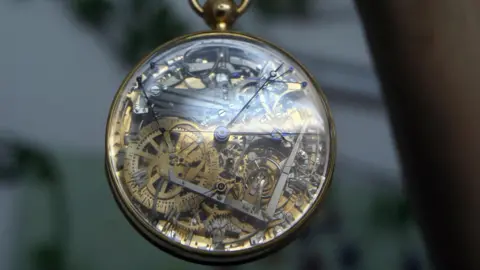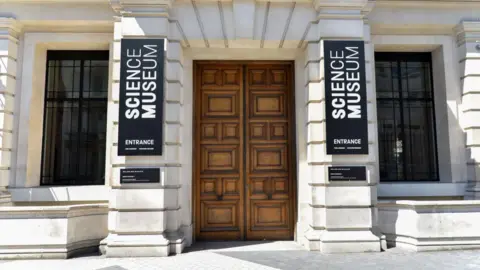 Getty Images
Getty ImagesA watch made for Marie Antoinette is to go on display for the first time in the UK, at London’s Science Museum.
Abraham-Louis Breguet‘s No.160 Marie Antoinette timepiece features rubies, sapphires, platinum and gold. It was created without a budget and has 823 parts.
Although intended for her, the famous French queen did not live long enough to see it finished.
Now the item will form part of the South Kensington museum’s Versailles: Science And Splendour exhibition, which opens on 12 December.
The last queen of France, Marie Antoinette was born in Austria in 1755 and sent to France to be the child bride of the future King Louis XVI.
She was guillotined in 1793 at the age of 37, along with her husband, at the height of the French Revolution.
Although Breguet was commissioned to create the watch in 1783, it was not completed until after his own death in 1827.
Nicknamed “the grand complication”, it is believed to be the most valuable watch in the world, and represents something of a holy grail for horologists.
It has a clear crystal dial revealing mechanisms which support on-demand sounding on the hour, quarter hour and minute; a perpetual calendar corrected for the leap year; a thermometer; and an independent second hand that acts as a stopwatch.
The watch was stolen in 1983 and was missing for more than two decades.
Its arrival in London marks the first time the watch has travelled abroad since its safe return to the LA Mayer Museum for Islamic Art in 2008.
 The Museum for Islamic Art/PA
The Museum for Islamic Art/PASir Ian Blatchford, director and chief executive of the Science Museum Group, said: “This glorious watch will thrill visitors to Versailles: Science And Splendour, and is one of the most remarkable items we have ever secured.
“Even in the smallest details, the watch perfectly encapsulates meticulous engineering and a dedication to knowledge and beauty, ideals which are echoed throughout our exhibition and at Versailles itself.”
David Rooney, author of About Time: A History Of Civilisation in Twelve Clocks, described the item as “the world’s most famed watch” and “a true masterpiece”.
 Getty Images
Getty ImagesThe exhibition will aim to take visitors on a 120-year journey through the evolution of science at the royal court, the Palace of Versailles, and explain how monarchs Louis XIV, Louis XV and Louis XVI encouraged scientific pursuit and drew on technological advances to enhance France’s prestige and extend its influence.
More than 100 objects will be on show, many of which have never before been displayed in the UK.
The exhibition will run until 21 April 2025. Tickets cost £12, with free entry for children aged 11 and under.
 SOPA Images/Getty
SOPA Images/Getty












































